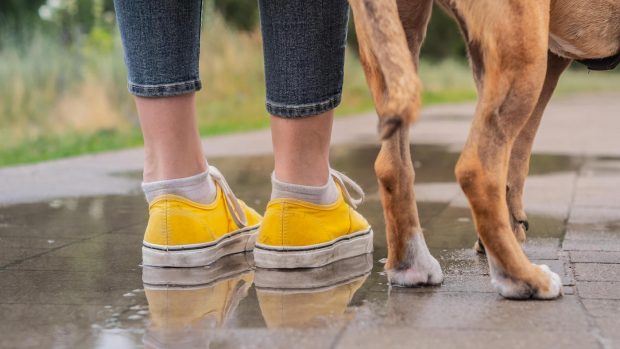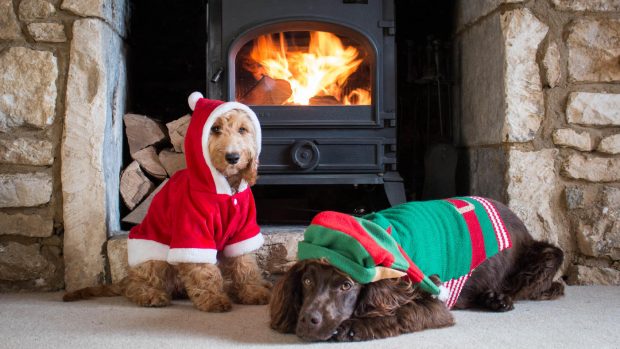Just as when the weather is too hot to walk your dog, walking him in very cold conditions can cause health and safety issues for your dog, too. The question of “When is it too cold to walk my dog?” might be something you’ve been wondering this week. This conundrum rarely gets the same attention as the hot weather scenario, but the repercussions can be just as devastating.
Like hot days, certain breeds are more prone to the health implications that cold days can bring. Puppies and tiny breeds cannot regulate their temperatures as well as other breeds. In the current cold snap, it’s too risky to allow our new addition, Derek the miniature dachshund, out at present due to his age and the fact that he is smooth coated, even in a fleece he is shivering in seconds. This can quickly lead to hypothermia if he were to be left out too long and so house training needs to wait another week.
When walking your dog in colder weather, remember that breed, size, age and the thickness of their coat can all make a difference in how your dog copes with the cold. A smaller, fine-coated dog walking in wet weather will not cope nearly as well as a larger, hairier breed in cold but dry weather. But, generally, if it feels too cold for you to be outside, it’s too chilly for your dog, too. If you’re unsure, opting for a shorter walk or indoor playtime to keep your dog safe and cosy is best.
Signs that it is too cold for your dog
Your dog…
- is shivering or shaking
- feels cold under their armpits and on their ears – although this is not as fool proof as some dogs have virtually no fur there
- is huddling or tucked up
- is seeking shelter in corners or under bushes if they’re outside
- whining and barking
- looking uncomfortable
- reluctant to walk
- lethargic
Health risks in the cold
It’s not just humans that can get frostbite and hypothermia during freezing weather; dogs can too. Frostbite is when the skin and tissues freeze, and hypothermia is when the body temperature drops. These are both serious conditions, so be sure to keep an eye out for early signs particularly if your dog has got very cold outside.
Frostbite symptoms
- Pale, grey, or blue skin
- Swelling and pain in the affected area
- Blisters on the skin
- Limping or avoiding putting weight on the affected limb
Frostbite can be painful, and your dog may need medication to help manage the pain. If you think your dog has frostbite, follow these steps:
- Call your vet right away – frostbite can cause serious tissue damage and early treatment is essential.
- Move your dog to a warm room.
- Gently warm the affected area with warm (not hot), moist towels or water – avoid heating the affected area too quickly as it could cause more damage.
- Keep an eye on your dog and look for any changes in their condition.
Hypothermia symptoms
- Shivering to warm up.
- Lethargy and appearing sluggish and tired.
- Slow heart rate
- Muscle stiffness
- Shallow or laboured breathing
- Pale or blue gums
- In severe cases, dogs may lose consciousness.
If you think your dog might be suffering from hypothermia, you must act quickly and take the following steps:
- Contact your vet immediately – hypothermia can be a serious condition, and early treatment is crucial.
- Move your dog to a warm room and cover them with a blanket to help warm up.
- Offer warm water to drink to help raise your dog’s body temperature.
- Keep a close eye on your dog and watch for any changes in their condition until you can be seen by your vet.
Harmful winter substances
Ice-melting chemicals, such as rock salt/grit
This can cause dehydration or burns in your dog’s mouth and throat, as well as irritation to their paws.
Antifreeze
This can be harmful to your dog if ingested. It contains a chemical called ethylene glycol, which has a sweet taste that might tempt your dog to try to eat it, so make sure to keep it out of reach. It can also cause irritation and dryness to the paws and might be ingested when your dog licks their paws as part of self-grooming. It’s essential to clean your dog’s paws after walking in areas where it has been used. If you suspect your dog has ingested antifreeze, get in touch with your vet immediately.
Ice
Try to avoid icy pools of water and ice water ponds. If you allow your dog to run in iced-over puddles, these can easily crack and are quite capable of slicing a paw pad. Frozen and extremely cold streams and ponds should be avoided due to the risk of hypothermia.
What to do if it’s too cold to walk your dog
There is no shame in putting one of the best dog coats on your dog – the view that a dog has fur and doesn’t need a coat is outdated. The breeds that are more susceptible to the cold are your fine-skinned and smooth-coated breeds, such as greyhounds (Italian ones especially), whippets, vizslas, ridgebacks, pointers, smooth haired dachshunds and your toy breeds. All these dogs’ benefit from a fleece – and with one of the best waterproof dog coats on top in some instances. I even put fleeces on my mastiffs – especially my older ones – as it helps to keep them warm and really helps with keeping them clean too.
In the very cold weather, particularly if temperatures do not get above 0°C, I tend to avoid pavements and grass that has frozen over as they’re so cold. Not many people have access to astroturf, but if you’re near the coast the beach is quite a good place to go – depending on the windchill and the tide. Local woods and forest may work out better too as the tress can provide some respite from the biting cold and the ground tends not to be as frozen solid due to the leaf cover on the ground and the canopy of the trees.
If you do need to walk your dog on pavements, consider a pair of the best shoes for dogs. These are widely used for hikers and mountain climbers’ dogs who cover a lot of miles over rough terrain. It is worth noting that should you purchase boots, you need to get your dog used to the feel and the fit of a boot before any extreme weather arrives.
Alternatives to walking in cold weather
There are a variety of ways to keep your dog entertained indoors. I have one of the best automatic ball launchers, which is not for the faint hearted if you have three mastiffs, an Irish terrier and a dachshund, although he tends to keep out of the way. The best snuffle mats are a great option, but a game of fetch with a soft toy, scent games and hiding things throughout the house are all forms of mental and albeit restricted physical exercise, too. They can help greatly on days when it’s too cold for your dog to go outside.
How to keep your dog warm at night
It’s more than just the outside temperature you need to be aware of during the winter months. Remember that when the heating goes off your house can get chilly at night and could leave your pet shivering in their usually cosy spot.
- Provide a warm, comfortable dog bed that’s off the ground and well-insulated, you can even put one of the best hot water bottles for dogs wrapped in a blanket underneath their usual bedding.
- Set a comfortable temperature in the room, ideally between 20–22°C
- Give your dog extra bedding, such as blankets or towels, to maintain their body heat and help protect them from the cold, mine sometimes sleep in their fleeces.
- Place your dog’s bed away from draughty windows and doors.
- Avoid letting your dog sleep in unheated areas, such as a garage or porch.
You might also like:

The best waterproof canine coats to keep your dog cosy and dry whatever the weather

Cosy up in the colder weather: hot water bottles for dogs

Booties to protect your dog’s paws against frost, flints and burning tarmac

Best dog coats for warmth, wet walks and drying off afterwards

Best snuffle mats for dogs to mimic their natural foraging instinct

6 of the best puzzle toys to boost your dog’s IQ (and keep him out of mischief)

Sit back and watch your dog in action with an automatic ball throwing machine

Subscribe to Horse & Hound magazine today – and enjoy unlimited website access all year round
Horse & Hound magazine, out every Thursday, is packed with all the latest news and reports, as well as interviews, specials, nostalgia, vet and training advice. Find how you can enjoy the magazine delivered to your door every week, plus options to upgrade your subscription to access our online service that brings you breaking news and reports as well as other benefits.




